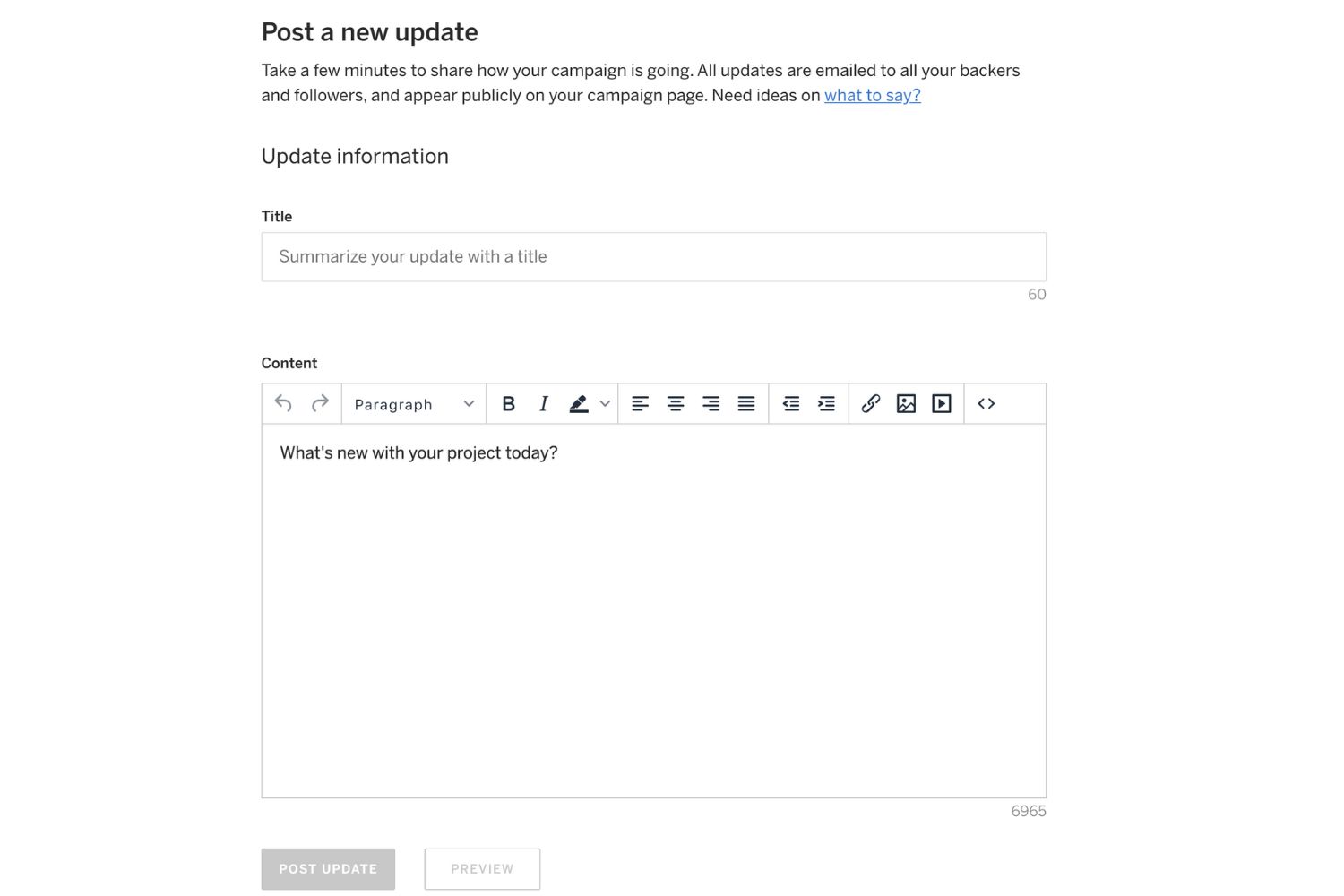Introduction
Welcome to the exciting world of crowdfunding! If you have a brilliant idea or a project that needs funding, then crowdfunding can be the perfect solution for you. Crowdfunding allows entrepreneurs, artists, and innovators to raise money by harnessing the power of the crowd.
In this article, we will guide you through the process of writing a successful crowdfunding campaign. From understanding the basics of crowdfunding to crafting a compelling story and choosing the right platform, we will cover all the essential steps to help you achieve your funding goals.
Whether you’re looking to launch a new product, fund a creative project, or support a cause, crowdfunding offers a unique opportunity to connect with a community of backers who share your passion and believe in your vision. By effectively communicating your project’s value and showcasing your determination, you can inspire people to support your campaign.
However, while the concept of crowdfunding may seem straightforward, executing a successful campaign requires careful planning, strategizing, and effective storytelling. It’s not just about asking for money; it’s about convincing potential backers that your project is worth their investment.
Throughout this article, we will provide you with valuable insights and practical tips to help you navigate the crowdfunding landscape and increase your chances of running a successful campaign. By following these guidelines, you will be well-equipped to create an engaging campaign that captures the attention of your target audience and motivates them to contribute to your project.
So, if you’re ready to embark on this exciting crowdfunding journey, let’s dive in and discover how to write a compelling crowdfunding campaign that will captivate and inspire your potential backers!
Understanding Crowdfunding
Crowdfunding is a funding model that allows individuals to raise money for their projects or ventures by seeking small contributions from a large number of people, typically through an online platform. This alternative form of fundraising has grown in popularity over the years, revolutionizing the way ideas are brought to life.
One of the key advantages of crowdfunding is its ability to bypass traditional financial institutions and allow aspiring entrepreneurs, artists, and innovators to directly connect with potential investors – the crowd. This democratized approach to funding opens doors for individuals who may have struggled to secure funding through conventional means.
There are several types of crowdfunding, including donation-based crowdfunding, reward-based crowdfunding, equity-based crowdfunding, and debt-based crowdfunding. Each type has its own unique characteristics and benefits, catering to different project goals and funding requirements.
In donation-based crowdfunding, supporters contribute money without expecting anything in return. This model is often used for charitable causes, community projects, and disaster relief efforts, where individuals are driven by the desire to make a positive impact.
Reward-based crowdfunding, on the other hand, allows project creators to offer incentives, rewards, or pre-orders to their backers. These rewards can range from small tokens of appreciation to exclusive access to the product or even personalized experiences. This model is particularly popular among artists, product designers, and independent filmmakers.
Equity-based crowdfunding involves offering shares or ownership in a company in exchange for financial support. This model is suitable for startups and businesses seeking expansion capital. Backers become investors with the potential for financial returns based on the success of the venture.
Debt-based crowdfunding, also known as peer-to-peer lending, enables individuals or businesses to borrow money from the crowd and repay it with interest over a specified period. This model is especially beneficial for entrepreneurs who may find it challenging to obtain loans from traditional financial institutions.
Now that you have a basic understanding of crowdfunding, it’s time to move on to the next step: setting clear goals for your campaign. By defining your objectives and expectations, you can create a focused and compelling campaign that resonates with your target audience.
Setting Clear Goals
Setting clear and realistic goals is crucial for a successful crowdfunding campaign. Before launching your campaign, take the time to define what you want to achieve and how you will measure your progress. Clear goals not only provide direction but also help you communicate your vision effectively to potential backers.
When setting your crowdfunding goals, consider the following points:
- Funding Target: Determine the amount of money you need to bring your project to life. Consider all the costs involved, including production, marketing, distribution, and any other expenses related to delivering on your promises to backers.
- Timeline: Set a realistic timeline for your project. Consider the time it will take to complete your work and deliver rewards to backers. Be mindful of potential delays and give yourself a buffer to account for unexpected challenges.
- Milestones: Break down your project into milestones to demonstrate progress. This can help motivate backers by showing that you are making steady progress towards your ultimate goal.
- Stretch Goals: Consider setting stretch goals to encourage continued support from backers. Stretch goals are additional funding targets that, when reached, unlock additional features, upgrades, or enhancements to your project. This can help sustain momentum and keep backers engaged even after your initial funding goal is met.
- Non-Financial Objectives: While crowdfunding is primarily about raising money, it can also help you achieve other objectives. Identify any non-financial goals you may have, such as building a community, raising awareness for a cause, or validating market demand for your product or idea.
When setting your goals, make sure they are specific, measurable, achievable, relevant, and time-bound (SMART). This will help you stay focused and provide a clear roadmap towards achieving your desired outcomes.
Communicate your goals clearly in your crowdfunding campaign description and other promotional materials. Let potential backers know exactly what you need the funds for and how their support will contribute to your project’s success. Transparency and honesty are crucial in building trust with your audience.
Remember, setting clear goals is not just about attracting backers; it’s also about managing expectations. Be open and realistic about the potential risks and challenges associated with your project. This will help build credibility and trust with your backers.
By setting clear and well-defined goals, you will not only motivate yourself to stay on track but also inspire potential backers to rally behind your project. Now that you have your goals in place, it’s time to build the right team to help bring your vision to life.
Building the Right Team
Building the right team is crucial for the success of your crowdfunding campaign. While you may have a great idea, it’s the collective effort of a skilled and dedicated team that will help you bring that idea to life and effectively manage your campaign.
Here are some key considerations when building your crowdfunding team:
- Identify Your Needs: Assess your strengths and weaknesses to determine what skills are necessary to execute your campaign successfully. This may include areas such as marketing, design, video production, copywriting, public relations, and project management.
- Recruit Complementary Talents: Look for team members who bring diverse skills and expertise to the table. This can help cover a wide range of tasks and ensure that all aspects of your crowdfunding campaign are well-managed.
- Shared Vision and Passion: Ensure that all team members are aligned with your project’s vision and are genuinely passionate about it. Building a team of individuals who believe in your cause will lead to greater dedication and creativity.
- Communication and Collaboration: Effective communication is essential for any team. Foster an environment where open and regular communication takes place, allowing for feedback, brainstorming, and problem-solving. Collaboration tools like project management software can help streamline the workflow and keep everyone on the same page.
- Delegate Responsibility: Assign specific roles and responsibilities to each team member based on their skills and strengths. This will help create a clear system of accountability and ensure that tasks are completed efficiently.
- Utilize Your Network: Tap into your existing network and connections to find potential team members. Reach out to friends, colleagues, and industry professionals who may be interested in joining your project. You can also consider posting job listings on relevant platforms or attending networking events to find potential teammates.
- Offer Incentives: Depending on your resources, consider offering team members incentives such as equity, revenue sharing, or future employment opportunities. This can help attract talented individuals who are motivated to contribute their skills to the success of your campaign.
Remember, building a strong team is not just about the skills and experience of individual team members. It’s also about fostering a positive and collaborative environment where team members can thrive and contribute their best work.
By assembling a dedicated and talented team, you will be able to divide and conquer the various aspects of your crowdfunding campaign, maximizing your chances of success. With your team in place, it’s time to move on to the next step – identifying your target audience.
Identifying Your Target Audience
Understanding your target audience is essential for a successful crowdfunding campaign. By identifying who your ideal backers are, you can tailor your messaging, marketing strategies, and rewards to resonate with their interests and motivations.
Here are some steps to help you identify and define your target audience:
- Research: Conduct market research to gain insights into your potential backers. Explore similar projects, competitors, or campaigns that have successfully attracted your desired audience. Analyze their demographics, interests, and behaviors to get a better understanding of who your target audience might be.
- Demographics: Define the demographic characteristics of your target audience, such as age, gender, location, income level, and education. These factors will shape your marketing messaging and help you target your campaign effectively.
- Psychographics: Dive deeper into your audience’s psychographic profile, including their interests, values, beliefs, lifestyle, and purchasing habits. Understand what motivates them and what problems your project can solve for them.
- Customer Personas: Create customer personas, which are fictional representations of your ideal backers. Give each persona a name, background, goals, and challenges. This exercise helps humanize your audience and allows you to personalize your messaging.
- Feedback and Surveys: Engage with your existing audience or potential backers through surveys or feedback forms. Ask for their opinions, preferences, and expectations. This firsthand information will help you better understand their needs and cater to them.
- Social Media Listening: Monitor social media platforms and online communities related to your industry or niche. Pay attention to conversations, comments, and discussions to gain insights into the thoughts and sentiments of your target audience.
- Test and Iterate: Validate your assumptions by running small-scale tests or pilot campaigns. Measure the response and engagement from different audience segments to refine your targeting and messaging strategy.
Once you have a clear understanding of your target audience, you can tailor your messaging and marketing efforts to appeal to their specific needs and interests. Craft your campaign story in a way that resonates with their aspirations, desires, or challenges.
By effectively identifying and engaging with your target audience, you can maximize your chances of connecting with the right backers who believe in your project and are willing to contribute. With your target audience defined, it’s time to focus on crafting a compelling story that will captivate and inspire them.
Crafting a Compelling Story
A compelling story lies at the heart of a successful crowdfunding campaign. It is the narrative that captures the attention and emotions of your potential backers, inspiring them to invest in your project. Craft your story in a way that connects with your audience, evokes empathy, and leaves a lasting impression.
Here are some key elements to consider when crafting your crowdfunding campaign story:
- Start with a Hook: Grab your audience’s attention from the very beginning. Start your story with a hook that piques curiosity, sparks intrigue, or poses a question. This will draw people in and make them eager to learn more.
- Introduce the Problem: Clearly articulate the problem or challenge that your project aims to solve. Highlight the pain points and frustrations that your target audience may be experiencing. Make them feel understood and empathize with their struggles.
- Share Your Vision: Paint a vivid picture of the future that your project can create. Describe the positive impact and transformation that your project can bring. Help your audience envision a better, brighter world with your product or idea.
- Inject Personal Narrative: Incorporate personal anecdotes or stories to add human elements to your campaign. Share your own journey, your motivations, and the obstacles you’ve overcome. This helps build trust, relatability, and authenticity.
- Showcase Benefits: Clearly communicate the unique features and benefits of your project. Focus on how it can enhance the lives of your backers or solve their problems. Describe the value they will receive by supporting your campaign.
- Visualize with Imagery: Incorporate visually appealing images, videos, or infographics to enhance the storytelling experience. Visuals can evoke emotions, create a stronger connection, and communicate the essence of your project more effectively.
- Highlight Social Proof: Include any testimonials, endorsements, or social proof that can boost your credibility. People are more likely to support a project if they see that others have already expressed their trust and positive experiences.
- Create a Call-to-Action: End your story with a powerful call-to-action that encourages your audience to take the next step. Whether it’s contributing to your campaign, sharing your story, or following your social media accounts, make it clear what you want them to do.
Remember, your crowdfunding campaign story needs to be authentic, relatable, and engaging. Connect with your audience on an emotional level, making them not only understand but also feel the importance and impact of your project.
As you craft your story, keep in mind the values, aspirations, and motivations of your target audience. Tailor your messaging to speak directly to them and make them feel like a part of your journey.
Once you have created a compelling story, it’s time to choose the right platform to host your crowdfunding campaign. We will delve into this topic in the next section.
Choosing the Right Platform
Selecting the right crowdfunding platform is crucial for the success of your campaign. There are numerous platforms available, each with its own features, audience, and fee structures. Here are some key factors to consider when choosing the right platform for your campaign:
- Project Focus: Different crowdfunding platforms cater to specific niches or industries. Consider platforms that align with the nature of your project. For example, if you are launching a creative project, platforms like Kickstarter or Indiegogo may be more suitable. On the other hand, if you are seeking investment in a business venture, platforms like SeedInvest or Fundable may be a better fit.
- Geographic Reach: Some platforms have a global presence, while others may be more localized. Determine where your target audience is and choose a platform that has a strong presence in those regions. This will help maximize your campaign’s visibility and attract backers who are more likely to support your project.
- Platform Fees and Policies: Understand the fee structure of the platform, including any listing fees, transaction fees, or other charges that may apply. Take into consideration the platform’s policies on receiving funds, managing refunds, and handling failed campaigns. It’s crucial to choose a platform that aligns with your budget and offers fair and transparent policies.
- Visibility and Promotion: Research the marketing support provided by the platform. Some platforms offer additional promotional opportunities, featured campaign slots, or partnerships that can amplify your campaign’s reach. Consider the platform’s reputation and ability to attract potential backers to ensure maximum visibility for your project.
- Social and Community Features: Explore the social and community features of the platform. Look for platforms that facilitate interaction and engagement with backers, such as comment sections, backer updates, or project updates. These features can help you build a stronger connection with your audience and foster a sense of community around your campaign.
- Success Stories and Campaign History: Review success stories and past campaigns on the platform. Analyze the type of projects that have been successful, the funding amounts they achieved, and the level of engagement they received. This can give you insights into the platform’s track record and the potential for success with your own campaign.
- Platform Support and Resources: Consider the level of support and resources provided by the platform. Look for platforms that offer educational materials, guides, or a dedicated support team to assist you throughout the campaign process. Having access to resources and expert assistance can greatly enhance your chances of running a successful campaign.
Take your time to research and compare different crowdfunding platforms before making a decision. Carefully weigh the pros and cons of each platform based on your project’s specific requirements.
It’s also worth considering the possibility of using multiple platforms if it aligns with your campaign strategy. Running parallel campaigns on different platforms can broaden your reach and attract backers from diverse communities.
Once you have chosen the right crowdfunding platform, it’s time to focus on creating an engaging video that will further captivate your potential backers.
Creating an Engaging Video
An engaging video is a powerful tool to convey your campaign’s message and capture the attention of your audience. It provides an opportunity to showcase the personality behind your project, demonstrate its unique features, and connect with potential backers on a deeper level. Here are some essential steps to create an impactful crowdfunding video:
- Start with a Hook: Grab the viewer’s attention from the beginning with a captivating opening. Use strong visuals, compelling statements, or intriguing storytelling techniques to make them curious and eager to learn more.
- Clearly Communicate the Problem: Clearly articulate the problem or challenge your project addresses. Use visuals and narratives to make the viewer understand and empathize with the pain points your project aims to solve.
- Showcase Your Solution: Illustrate how your project offers a unique solution to the problem. Demonstrate its features, benefits, and how it can improve the lives of your target audience. Use visuals and testimonials to make your solution tangible and relatable.
- Share Your Story: Introduce yourself, your team, or the inspiration behind your project. Share personal anecdotes, struggles, or achievements that highlight your passion and commitment. This human touch helps build trust and connection.
- Include Engaging Visuals: Incorporate high-quality visuals, including product shots, animations, or infographics that showcase the best aspects of your project. Use visuals that evoke emotions and create a strong visual impact.
- Keep it Concise: Attention spans are short, so aim for a video length of around 1-3 minutes. Keep the content focused, concise, and avoid unnecessary details that may distract or overwhelm the viewer.
- Be Authentic and Engaging: Be yourself and let your passion shine through. Speak sincerely and confidently about your project, emphasizing why it matters and why people should support it. Be natural and relatable to create a genuine connection with the viewer.
- Include a Call-to-Action: End the video with a clear call-to-action that prompts the viewer to take the next step, such as contributing to the campaign, sharing it on social media, or signing up for updates. Make it easy for viewers to engage with your project.
- Professional Quality: Invest in creating a high-quality video that reflects the professionalism of your project. It’s worth considering hiring a professional videographer, using good lighting, clear audio, and editing techniques to ensure a polished and engaging final product.
- Optimize for Mobile: With an increasing number of people accessing content through mobile devices, make sure your video is optimized for mobile viewing. Use subtitles or captions for viewers who may watch without sound, and ensure the video loads quickly and displays well on smaller screens.
An engaging video can significantly increase the chances of capturing the attention and interest of potential backers. It’s an opportunity to create a lasting impression that compels viewers to support your campaign and share it with others.
Once you have created an engaging video, it’s time to focus on crafting attractive rewards and perks to incentivize your backers. We will explore this topic in the next section.
Setting Rewards and Perks
Setting attractive rewards and perks is a crucial aspect of your crowdfunding campaign. It serves as an incentive for potential backers to support your project and plays a significant role in motivating them to contribute. When creating your rewards and perks, consider the following:
- Tiered Structure: Create a tiered structure of rewards to cater to different levels of contributions. Offer a variety of options that appeal to a range of budgets and interests. This allows backers to choose a reward that aligns with their level of support.
- Early Bird Rewards: Encourage early support by featuring limited-quantity early bird rewards. These exclusive perks are offered at a discounted price or with additional benefits, enticing backers to pledge their support early on and create a sense of urgency.
- Unique and Exclusive: Make your rewards special and exclusive to your campaign. Offer limited edition or personalized items that backers can’t easily get elsewhere. This creates a sense of exclusivity and makes your rewards more compelling.
- Value for Money: Ensure that your rewards offer perceived value to backers. Consider the cost of production, shipping, and other expenses when determining the pricing of your rewards. Strive to provide rewards that exceed the monetary value of the contribution.
- Stretch Goals: Align certain rewards with stretch goals to incentivize increased funding. As you reach specific funding milestones, unlock new rewards or enhance existing ones. This keeps the momentum going and encourages backers to continue supporting your campaign.
- Backer Involvement: Consider offering rewards that involve backers in the project’s development. This can include exclusive access to behind-the-scenes updates, beta testing opportunities, or even involving them in the decision-making process. Backer involvement fosters a deeper connection and can help build a community around your project.
- Clear and Realistic Delivery Timeline: Provide a clear timeline for when rewards will be delivered to backers. It’s crucial to set realistic expectations and account for any potential delays or unforeseen circumstances. Communicate any potential risks upfront to build trust with your backers.
- Add-Ons and Upgrades: Offer additional add-ons or upgrades that backers can purchase alongside their chosen reward. This allows them to customize their support and potentially increases the overall contribution amount of each backer.
- Thank-You Notes and Appreciation: Express gratitude to your backers by including personalized thank-you notes or acknowledgments with their rewards. This small gesture goes a long way in building rapport and fostering a positive relationship with your supporters.
- Test and Iterate: Pay attention to backer feedback and response to your rewards. If certain rewards are not receiving much interest or if backers are requesting specific additions, be open to adjusting your reward structure. Continuously refine your rewards based on the needs and preferences of your backers.
The key to setting rewards and perks is to make them appealing, valuable, and aligned with the desires and expectations of your target audience. Offering enticing rewards not only incentivizes potential backers to support your campaign but also shows your appreciation for their contribution.
With your rewards and perks in place, it’s time to focus on crafting a compelling and persuasive campaign description. In the next section, we will explore the essentials of writing an effective campaign description.
Writing the Campaign Description
The campaign description is a crucial element of your crowdfunding campaign. It is where you communicate the essence of your project, share your vision, and convince potential backers to support your campaign. When writing the campaign description, consider the following:
- Start with a Compelling Opening: Capture the reader’s attention from the beginning with a compelling and attention-grabbing opening. Use a strong hook, an intriguing question, or a captivating sentence that makes them want to read on.
- Clearly Articulate Your Project: Describe your project in a clear and concise manner. Clearly explain what your project is about, what problem it solves, and why it is unique or innovative. Use simple language and avoid technical jargon that may confuse or alienate potential backers.
- Convey Your Passion and Purpose: Share your passion and excitement for the project. Communicate why this project is important to you and how it aligns with your values. This helps create an emotional connection and motivates potential backers to support your campaign.
- Highlight the Benefits: Clearly communicate the benefits and value that your project brings to backers. Explain how your project will enhance their lives, solve their problems, or fulfill their desires. Focus on the tangible and intangible benefits that they will receive through their support.
- Use Visuals and Multimedia: Enhance your campaign description with images, videos, infographics, or prototypes that visually represent your project. Visuals help bring your project to life, make it more engaging, and convey information more effectively.
- Include Milestones and Progress: Showcase the progress you have made so far and any significant milestones achieved. This helps build trust and demonstrates that you have already put in the work to bring your project to where it is today.
- Break It Down: Organize your campaign description into sections or subsections that are easy to navigate. This helps readers find information quickly and makes your campaign description more skimmable and accessible.
- Tell a Story: Incorporate storytelling elements to make your campaign description more engaging and relatable. Share personal anecdotes, user testimonials, or stories of how your project has impacted others. Stories create an emotional connection and inspire potential backers to become a part of your project’s journey.
- Include a Call-to-Action: Prompt potential backers to take action by including a clear and compelling call-to-action. Encourage them to contribute to your campaign, share it with their networks, or follow your social media accounts. Make it easy for them to take the next step.
- Be Transparent and Honest: Be transparent about your project’s risks and challenges. Acknowledge any potential pitfalls or obstacles and explain how you plan to address them. Transparency builds trust and credibility with potential backers.
- Edit and Proofread: Review and edit your campaign description for clarity, grammar, and spelling errors. A well-written and error-free campaign description conveys professionalism and attention to detail.
Remember to write your campaign description with your target audience in mind. Use language and tone that resonates with them and addresses their specific needs and interests. Craft a description that is persuasive, authentic, and compelling, leaving potential backers eager to support your campaign.
With your captivating campaign description ready, it’s time to set a realistic funding goal for your campaign. We will explore this topic in the next section.
Setting a Realistic Funding Goal
Setting a realistic funding goal is a critical step in planning your crowdfunding campaign. Your funding goal represents the amount of money you aim to raise to bring your project to life. It is essential to set a goal that is attainable yet sufficient to cover your project expenses. Here are some considerations when setting your funding goal:
- Project Budget: Determine the total budget required to complete your project successfully. Consider all expenses, including production costs, manufacturing, shipping, marketing, and any other logistical or operational expenses. Your funding goal should cover these costs to ensure the project’s success.
- Research and Validation: Conduct thorough research to understand the market and industry standards for similar projects. Analyze past successful campaigns to gauge the average funding targets achieved within your niche. This will help you set a goal that aligns with realistic expectations and market demand.
- Backer Expectations: Consider the average contribution per backer and the number of backers you expect to attract. Calculate how many backers you need to reach your funding goal based on these factors. Ensure your goal is attainable within the estimated number of backers.
- Stretch Goals: Incorporate stretch goals into your funding strategy. These are additional funding targets beyond your initial goal that unlock new features, upgrades, or rewards. Stretch goals can encourage continued support and give backers something to strive for, increasing the overall funding of your campaign.
- Manageable and Realistic: Set a funding goal that is achievable based on your project’s scope, timeline, and the size of your existing network or potential target audience. Avoid setting a goal that is excessively high or unrealistic, as it may deter potential backers who perceive it as unattainable.
- Consider Platform Fees: Take into account the fees charged by the crowdfunding platform when determining your funding goal. These fees can range from a percentage of the total funds raised to fixed transaction fees. Factor in these costs to ensure you receive enough funds to cover your project expenses.
- Padding for Unexpected Costs: It’s wise to include a buffer in your funding goal to account for any unexpected costs or delays that may arise during the project. Having a margin of safety helps protect against potential setbacks and ensures you can deliver on your promises to backers.
- Communicate Transparency: Be transparent with your backers about how you arrived at your funding goal. Clearly outline the expenses it will cover and the value they will receive in return for their contributions. Backers appreciate transparency and want to support projects with clear intentions and financial planning.
Setting a realistic funding goal is essential not only for the success of your campaign but also to maintain credibility and trust with your backers. It’s better to set a modest and achievable goal that you can exceed rather than setting an unrealistic goal that may result in a failed campaign.
By carefully considering your project budget, conducting market research, and factoring in backer expectations, you can set a funding goal that propels your project forward and sets it up for success. With your funding goal in place, it’s time to plan a robust marketing strategy for your crowdfunding campaign. We will explore this topic in the next section.
Planning a Marketing Strategy
A well-executed marketing strategy is essential to maximize the visibility and success of your crowdfunding campaign. It involves identifying your target audience, creating compelling messaging, and deploying various promotional channels to reach potential backers. Here are some key steps to consider when planning your crowdfunding marketing strategy:
- Identify Your Target Audience: Refine your understanding of your target audience and create customer personas. Clearly define the demographics, psychographics, and interests of your ideal backers. This will guide your marketing efforts and help you tailor your messaging appropriately.
- Create Compelling Messaging: Craft a clear and compelling message that clearly communicates the value of your project. Highlight the problem you’re solving, the benefits backers will receive, and the impact their support can make. Use persuasive language and storytelling techniques to engage your audience.
- Utilize Social Media: Leverage the power of social media platforms to connect with your audience and generate buzz. Create engaging content, share updates, and interact with your followers. Utilize social media advertising to target specific audience segments and promote your campaign to a wider audience.
- Content Marketing: Develop a content marketing strategy to generate interest and establish expertise within your niche. Create blog posts, videos, infographics, and other valuable content that educates and entertains your audience. Share this content through various channels to attract potential backers.
- Email Marketing: Build an email list of potential backers and develop a sequence of compelling email campaigns. Utilize targeted emails to nurture leads, provide updates, and encourage contributions. Personalize your emails to create a more personalized and engaging experience for each recipient.
- Influencer Outreach: Identify influencers in your industry or niche who align with your project and have a substantial following. Reach out to them and propose collaborations, product reviews, or endorsements. Influencers can help amplify your campaign reach and attract a wider audience.
- Media Outreach: Develop a press kit and reach out to relevant media outlets, journalists, and bloggers for potential coverage of your campaign. Pitch your project as a newsworthy story or highlight its unique aspects to garner attention from the media.
- Cross-Promotion: Collaborate with other creators or campaigns in your niche for cross-promotion opportunities. Partnering with complementary projects can help you tap into each other’s networks and expand your reach.
- Engage Your Network: Leverage your personal and professional networks to spread the word about your campaign. Reach out to friends, family, colleagues, and social media connections for support and ask them to share your campaign with their own networks.
- Regular Updates and Communication: Keep your backers engaged and informed by providing regular updates on your campaign’s progress. Communicate milestones, new rewards, and any challenges or setbacks you may encounter. Respond to questions and comments promptly to demonstrate your commitment and build trust.
Remember, a successful marketing strategy is an ongoing effort. Continuously evaluate and refine your strategies based on the results and feedback you receive. Track your campaign’s progress, analyze data, and make data-driven decisions to optimize your marketing efforts.
By employing a well-planned marketing strategy, you can increase awareness, attract the right audience, and inspire potential backers to support your project. With your marketing strategy in place, it’s time to prepare for the pre-launch phase of your crowdfunding campaign.
Pre-Launch Preparation
The pre-launch phase of your crowdfunding campaign is crucial for laying a strong foundation and generating early momentum. Proper preparation during this stage can significantly impact the success of your campaign. Here are key steps to take during the pre-launch preparation:
- Campaign Website: Create a dedicated campaign website or landing page that provides detailed information about your project. Make sure it is visually appealing, mobile-friendly, and optimized for conversion. Include compelling visuals, captivating headlines, and clear calls-to-action to encourage visitors to sign up for updates or support your campaign.
- Build a Mailing List: Prioritize building an email list of potential backers during the pre-launch phase. Offer incentives, such as exclusive content or early-bird perks, to encourage visitors to subscribe to your newsletter. Use email marketing software to manage your list and communicate updates leading up to the campaign launch.
- Teaser Campaign: Generate excitement and anticipation by running a teaser campaign prior to the launch. Create teaser videos, social media posts, or behind-the-scenes content to give potential backers a sneak peek into your project. This builds anticipation and helps generate a sense of curiosity and interest.
- Social Media Presence: Establish a strong presence on social media platforms that align with your target audience. Build a following, engage with your audience, and share relevant content. Use social media platforms to tease your upcoming campaign, host giveaways, and attract potential backers.
- Reach Out to Influencers: Identify influencers or bloggers who can help spread the word about your campaign. Build relationships with them, share your project details, and propose collaboration opportunities. Influencers can help extend your reach and generate buzz around your campaign.
- Prepare Media Materials: Create a press kit with high-quality images, videos, press releases, and project details. Reach out to media outlets, journalists, and bloggers who cover your industry or niche. Present your project as a compelling story and offer to provide additional information or interviews prior to the campaign launch.
- Refine Your Messaging: Continuously refine and fine-tune your campaign messaging based on feedback and responses. Test different taglines, descriptions, and visuals to identify what resonates most with your target audience. Craft a strong value proposition that clearly communicates the benefits of supporting your project.
- Plan Launch Events: Consider organizing launch events or online live streams to create a sense of excitement and engagement. Host virtual launch parties, live Q&A sessions, or exclusive backer-only events. These events can generate buzz and motivate early support.
- Prepare Kickstarter or Indiegogo Campaign Pages: If you are using a platform like Kickstarter or Indiegogo, carefully design and optimize your campaign pages. Craft compelling headlines, engaging descriptions, and showcase your rewards effectively. Use high-quality visuals and videos to create a visually appealing and persuasive campaign page.
- Test Run Everything: Before launching your campaign, thoroughly test all links, forms, and payment gateways to ensure everything is functioning smoothly. Double-check your campaign page, emails, and any other communications for any errors or inconsistencies. A seamless pre-launch experience sets a positive tone for your campaign.
The pre-launch phase is an opportunity to build anticipation, generate interest, and gather early support for your crowdfunding campaign. By investing time and effort in careful preparation, you can set yourself up for a successful launch and pave the way for a strong campaign momentum.
With your pre-launch preparations completed, it’s time to launch your crowdfunding campaign and bring your project to life. We will explore the important steps to take during the campaign launch in the next section.
Launching Your Campaign
Finally, the moment has arrived to launch your crowdfunding campaign and introduce your project to the world. A successful campaign launch requires careful planning, effective promotion, and a solid communication strategy. Here are key steps to take when launching your campaign:
- Create a Launch Plan: Develop a detailed launch plan that outlines all the activities and strategies you will execute on the launch day. Set specific goals, define your messaging, and establish a timeline for executing each task.
- Send Email Blast: Utilize your email list gathered during the pre-launch phase to send an email blast announcing the launch of your campaign. Craft a compelling email that highlights the key aspects of your project and includes a clear call-to-action for readers to visit and support your campaign.
- Social Media Blitz: Leverage your social media channels to create a buzz around your campaign launch. Share engaging posts across all platforms, utilizing attention-grabbing visuals, captivating captions, and relevant hashtags. Encourage your followers to spread the word and share your campaign with their networks.
- Engage Your Network: Reach out to your personal and professional networks and ask for their support in promoting your campaign. Provide them with pre-written messages, images, or videos that they can easily share on their social media accounts or forward to their contacts.
- Monitor and Respond: Stay actively engaged with your campaign throughout the launch day. Monitor comments, questions, and feedback from potential backers across various platforms. Respond promptly, show appreciation for support, and address any concerns or inquiries in a timely manner.
- Launch Events and Promotions: Execute any launch events or promotions you have planned. This can include live streams, giveaways, or exclusive perks for early backers. Maintain excitement and encourage participation from your audience throughout the launch period.
- Media Outreach: Follow up with media outlets, journalists, or bloggers who expressed interest in covering your campaign. Provide them with any additional materials they may require for their coverage. Engage with influencers or partners to ensure maximum exposure for your campaign.
- Stay Consistent with Updates: Provide regular updates to your backers throughout the campaign. Share progress, milestones, and any new developments with transparency and enthusiasm. This reinforces trust and keeps backers motivated to continue supporting your project.
- Continuous Promotion: Maintain an ongoing marketing and promotional effort throughout your campaign. Regularly share updates, behind-the-scenes content, testimonials, or new rewards to keep the momentum going. Utilize various channels, including social media, email marketing, and media outreach, to expand your reach.
- Engage with Backers: Interact with your backers regularly, thanking them for their support, addressing their questions or concerns, and making them feel involved in your project’s journey. Engaging with backers builds a sense of community and loyalty.
Remember, the launch of your campaign is just the beginning. It sets the stage for the rest of your campaign, and the efforts you put into executing a successful launch will greatly impact its overall outcome. Stay proactive, adaptive, and responsive to the needs and expectations of your backers throughout the campaign.
With your campaign successfully launched, it’s time to execute post-campaign activities that will help you wrap up your campaign on a high note and fulfill the promises made to your backers. We will explore this topic in the next section.
Post-Campaign Activities
Congratulations on completing your crowdfunding campaign! While the campaign itself may be over, there are still important tasks and activities to undertake to ensure the successful fulfillment of your project and maintain a positive relationship with your backers. Here are key post-campaign activities to consider:
- Express Gratitude: Send a heartfelt thank-you message to all your backers, expressing your appreciation for their support, and acknowledging their role in making your project a reality. Show genuine gratitude for their trust and contribution throughout your campaign.
- Collect and Analyze Data: Review the data and analytics gathered during your campaign. Analyze the demographics, engagement levels, and insights you obtained to gain a better understanding of your audience and the effectiveness of your marketing efforts. This information can be valuable for future projects or campaigns.
- Respond to Backer Inquiries: Address any outstanding questions, comments, or concerns from your backers. Provide updates on the progress of your project, estimated delivery timelines for rewards, and any other relevant information they may need. Keep communication channels open with your backers and remain responsive throughout the fulfillment process.
- Fulfillment Planning: Prepare a detailed plan for fulfilling rewards and perks to your backers. Ensure you have a clear timeline, budget, and logistical arrangements in place. Develop a system for tracking and organizing backer information to streamline the fulfillment process.
- Regular Backer Updates: Keep your backers informed throughout the fulfillment phase. Provide regular updates on the progress, challenges, and milestones achieved. Share behind-the-scenes content, production updates, or sneak peeks to keep backers engaged and excited about the project.
- Resolve Issues Promptly: If any issues or obstacles arise during production or fulfillment, communicate them to your backers as soon as possible. Be transparent about the challenges and your plans to address them. Promptly resolve any problems or delays to maintain trust and credibility with your backers.
- Celebrate Success: Once you have fulfilled your obligations to your backers and completed the post-campaign activities, celebrate the success of your campaign. Share the achievements, milestones, and impact that your project has made. Express gratitude once again to your backers and the community that supported your campaign.
- Request Reviews and Testimonials: Reach out to your satisfied backers and request reviews or testimonials about their experience with your project. These reviews and testimonials can be valuable social proof for your future endeavors and can help attract new supporters.
- Reflect and Evaluate: Take the time to reflect on your crowdfunding experience. Evaluate what worked well and what could have been improved. Consider the feedback and insights gained from your backers and incorporate them into your future campaigns or projects to continually grow and refine your approach.
- Stay Engaged with Your Community: Maintain a connection with your backers and the community you built throughout your campaign. Continue providing updates on your projects, seek their feedback on new initiatives, and engage in conversations to foster a long-term relationship. They can become strong advocates for your brand in the future.
Remember, post-campaign activities are crucial for maintaining the trust and support of your backers. By fulfilling your promises, staying engaged, and expressing gratitude, you can continue to build a strong community that can support you in your future endeavors.
Take the time to reflect on your journey, celebrate your achievements, and leverage the knowledge and experience gained from your crowdfunding campaign for future projects or campaigns. With a solid post-campaign strategy in place, you can look forward to long-term success and continued growth.
Conclusion
Congratulations on completing this comprehensive guide on how to write a compelling crowdfunding campaign. We have covered numerous essential steps and strategies that will help you plan, launch, and manage a successful crowdfunding campaign.
From understanding the fundamentals of crowdfunding to setting clear goals, building the right team, identifying your target audience, and crafting a compelling story, each stage is crucial in creating a campaign that resonates with your audience and inspires them to support your project.
Choosing the right platform, creating an engaging video, setting attractive rewards and perks, and writing a persuasive campaign description are key elements that will significantly impact the success of your campaign. Additionally, planning a marketing strategy, preparing for the pre-launch phase, launching your campaign with a bang, and managing post-campaign activities are all critical components in ensuring the overall success and sustainability of your project.
Remember, a successful crowdfunding campaign requires dedication, planning, and continuous effort. Be open to learning from the process, adapting your strategies, and engaging with your backers throughout every step of the journey.
Now armed with the knowledge and strategies outlined in this guide, it’s time for you to embark on your own crowdfunding adventure. Take the first step, believe in your project, and reach out to the world for support. With careful planning, compelling storytelling, and a strong community of backers, you can turn your dreams into reality and bring your project to life.
Best of luck on your crowdfunding journey, and let your creativity and determination shine through as you make an impact with your unique project!

























